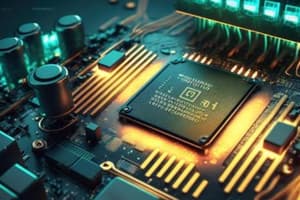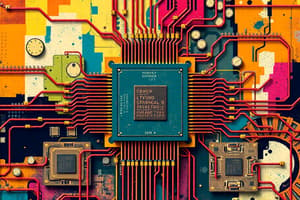Podcast
Questions and Answers
Na arquitetura de Von Neumann, qual das seguintes afirmações é verdadeira sobre o armazenamento de dados e instruções?
Na arquitetura de Von Neumann, qual das seguintes afirmações é verdadeira sobre o armazenamento de dados e instruções?
- As instruções são fixas e não podem ser alteradas após a criação do programa.
- A memória armazena apenas os dados, enquanto as instruções são armazenadas em cache na CPU.
- Um único bloco de memória armazena tanto os dados a serem manipulados quanto as instruções sobre o que fazer com esses dados. (correct)
- Dados e instruções são armazenados em blocos de memória separados e exclusivos.
Qual componente da CPU é responsável por realizar cálculos matemáticos e operações lógicas?
Qual componente da CPU é responsável por realizar cálculos matemáticos e operações lógicas?
- Dispositivos de entrada e saída (E/S)
- Unidade Lógica e Aritmética (ALU) (correct)
- Memória Cache
- Unidade de Controle
Qual das alternativas a seguir descreve corretamente o ciclo de busca e execução em uma CPU?
Qual das alternativas a seguir descreve corretamente o ciclo de busca e execução em uma CPU?
- A CPU solicita dados da memória, armazena esses dados em cache e executa a próxima instrução.
- A CPU executa todas as instruções em sequência, após ler todos os dados necessários da memória.
- A CPU armazena todas as instruções em um buffer, executa as operações lógicas e então grava os resultados na memória.
- A CPU busca uma instrução na memória, decodifica essa instrução, executa a instrução e repete o processo para a próxima instrução. (correct)
Qual a principal característica da memória RAM que a diferencia de outros tipos de memória?
Qual a principal característica da memória RAM que a diferencia de outros tipos de memória?
Qual a função da memória cache em um sistema de computação?
Qual a função da memória cache em um sistema de computação?
Como a memória virtual contribui para o funcionamento de um computador ao rodar programas exigentes?
Como a memória virtual contribui para o funcionamento de um computador ao rodar programas exigentes?
Qual a principal diferença entre HDs e SSDs em termos de desempenho e tecnologia?
Qual a principal diferença entre HDs e SSDs em termos de desempenho e tecnologia?
Qual a função do barramento de dados em um sistema de computação?
Qual a função do barramento de dados em um sistema de computação?
Em termos de arquitetura de processadores, qual a principal vantagem dos processadores multicore?
Em termos de arquitetura de processadores, qual a principal vantagem dos processadores multicore?
Qual a função do barramento de endereços em um sistema de computação?
Qual a função do barramento de endereços em um sistema de computação?
Flashcards
Von Neumann architecture
Von Neumann architecture
A computer architecture where a single memory block stores both data and instructions.
How a computer executes instructions
How a computer executes instructions
Executes instructions sequentially, fetching them from memory.
Central Processing Unit (CPU)
Central Processing Unit (CPU)
The component where processing occurs, contains ALU and Control Unit.
Arithmetic Logic Unit (ALU)
Arithmetic Logic Unit (ALU)
Signup and view all the flashcards
Control Unit
Control Unit
Signup and view all the flashcards
Memory
Memory
Signup and view all the flashcards
Input/Output (I/O) Devices
Input/Output (I/O) Devices
Signup and view all the flashcards
RAM (Random Access Memory)
RAM (Random Access Memory)
Signup and view all the flashcards
Data Bus
Data Bus
Signup and view all the flashcards
Cache Memory
Cache Memory
Signup and view all the flashcards
Study Notes
Von Neumann Architecture
- Prior to Von Neumann architecture, computers were designed for specific tasks with "fixed" instructions.
- A single memory block can store both the data a computer manipulates and the instructions on how to manipulate it.
- The computer executes instructions sequentially from memory.
- The computer has three essential parts
- Central Processing Unit (CPU)
- The CPU is where processing happens.
- It includes the Arithmetic Logic Unit (ALU)
- Performs mathematical calculations and logical operations.
- It also includes the Control Unit
- Coordinates the execution of instructions.
- Memory: Stores data and programs.
- Input/Output (I/O) Devices: Allow communication between the user and the computer (e.g., keyboard, mouse, monitor).
- Central Processing Unit (CPU)
Execution Cycle Step-by-Step
- The CPU fetches an instruction from memory.
- The instruction is decoded.
- The instruction is executed.
- The process repeats for the next instruction.
Processor Architectures
16-bit Processors
- Intel 8086 and 8088 processors were used in the first IBM PCs.
- They executed 16-bit instructions and could address up to 1MB of memory.
32-bit Processors
- Intel 80386, Pentium I, II, and III processors came after the 16-bit processors.
- They have greater processing capacity and support for up to 4GB of RAM.
- 32-bit processors are the foundation for operating systems like Windows 95 and Linux.
64-bit Processors
- Examples are AMD Athlon 64, Intel Core 2 Duo, and later processors.
- They have the ability to address terabytes of RAM.
- They allow for more efficient processing of advanced tasks, such as graphical computing and artificial intelligence.
Multicore Processors
- Traditionally, processors had only one core.
- Dual-core, quad-core, and octa-core processors permit the execution of multiple tasks in parallel.
- Multicore processors reduced energy consumption and improved performance in multitasking applications.
Types of Memory
RAM (Random Access Memory)
- RAM stores temporary data and instructions that are being executed.
- It is volatile; data is lost when the computer is turned off.
ROM (Read Only Memory)
- ROM stores firmware and permanent instructions.
- It cannot be altered by the user.
Cache Memory
- Cache memory is small but extremely fast.
- It reduces the access time to data frequently used by the CPU.
Virtual Memory
- Virtual memory uses part of the hard drive (HDD) or solid-state drive (SSD) as an extension of RAM.
- This helps run programs that require more memory than is available.
Storage
- HDDs (Hard Disk Drives) are slower and mechanical.
- SSDs (Solid State Drives) are faster and more reliable and are used in modern computers.
Buses: Connecting Components
Data Bus
- Transfers data between memory, CPU, and devices.
Address Bus
- Indicates where data is stored in memory.
Control Bus
- Coordinates the flow of information and defines whether data will be read or written.
Studying That Suits You
Use AI to generate personalized quizzes and flashcards to suit your learning preferences.





